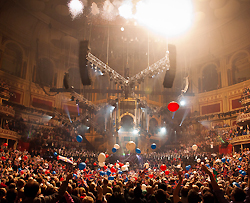Sound rental company RG Jones (London) has been producing sound reinforcement infrastructure for the challenging Raymond Gubbay Classical Spectaculars at London’s Royal Albert Hall since 1993.
With a production harnessing cannons, pyro and lasers in a festival type ‘Proms’ atmosphere, front of house engineer Simon Honywill’s expertise keeps the show’s audio fidelity evolving with each generation of new technology.
Honywill is no stranger to Martin Audio proprietary line array platforms, introducing W8L Longbow systems to the Glastonbury Pyramid stage, and taking the new MLA (Multi-Cellular Loudspeaker Array) system on tour with Jeff Wayne’s War Of The Worlds.
Rigging the MLA at the Royal Albert Hall for the first time ever this month, he knew the classical show would experience the same dynamic range and sudden transients as War of the Worlds––and in a venue notoriously difficult to control, he also knew it would clean up the room’s inherent reflections. But the performance, he said, was breathtaking, and even beyond his expectations.
“We’ve made a massive leap forward with the MLA. The results were remarkable,” reports Honywill.
At Royal Albert Hall, the two front arrays comprised 16 element MLA hangs per side, with no down fill enclosures, since the rig’s trim height was 40 feet (from the lowest box) to accommodate the huge lighting rig.
Side hang arrays of nine Martin Audio W8LM mini enclosures were balanced with a single W8LMD underneath to bring coverage down as far as possible; at the same time, a central sub-bass array of six WLX was recessed under the stage apron, which was electronically curved to optimize coverage.
Martin Audio’s Nigel Meddemmen served as a “de facto” systems engineer, walking the entire room to verify uniform sound balance. “The challenge was to match the warmth and smooth response of the MLA,” he notes, “a tricky task particularly on some of the operatic pieces with shrill soprano vocals which have a tendency to really show up deficiencies in the high frequency of a system.”
Meddemmen recounted that the design software was critical in ensuring optimum performance. “The calculations were based on Simon’s model of the slice through the venue, and with the advantages of the new Display 2.1 software, Ambrose [Thompson, Martin Audio Electroacoustic Engineer] was able to design a system with the correct splay angles.”
Honywill adds, “The fact that it sounded so astounding is testament to the software. In fact I have never heard a system [in the RAH] that sounded so similar upstairs as down. Ambrose was also able to rationalize the coverage to effectively reduce the amount of energy hitting the balcony fronts––other systems have claimed it but this is the first to deliver.”
The design prediction created ‘voids’ precisely where necessary––including the elimination of any stage spill, as Honywill was quick to attest. “You could stand under the MLA on stage and not hear a thing. But at the same time this is the loudest I have been able to drive a system here without the orchestra moaning.”
The program combined the traditional ‘greatest hits’ from the classical canon with new works such as Karl Jenkins’ Benedictus from The Armed Man; A Mass For Peace. The latter swings from the gentlest of solo cello to five percussionists hitting a variety of drums extremely hard and the choir adding weight to a huge sonic picture.
“We had 10 mics on the choir and I found I could keep opening them up massively, with no coloration whatsoever,” noted Honywill. “We’ve never had the amount of level, definition and control––particularly with the low strings––as we achieved with the MLA, and that is what makes it sound really fat. It was a pleasure and absolute joy to mix.”




















